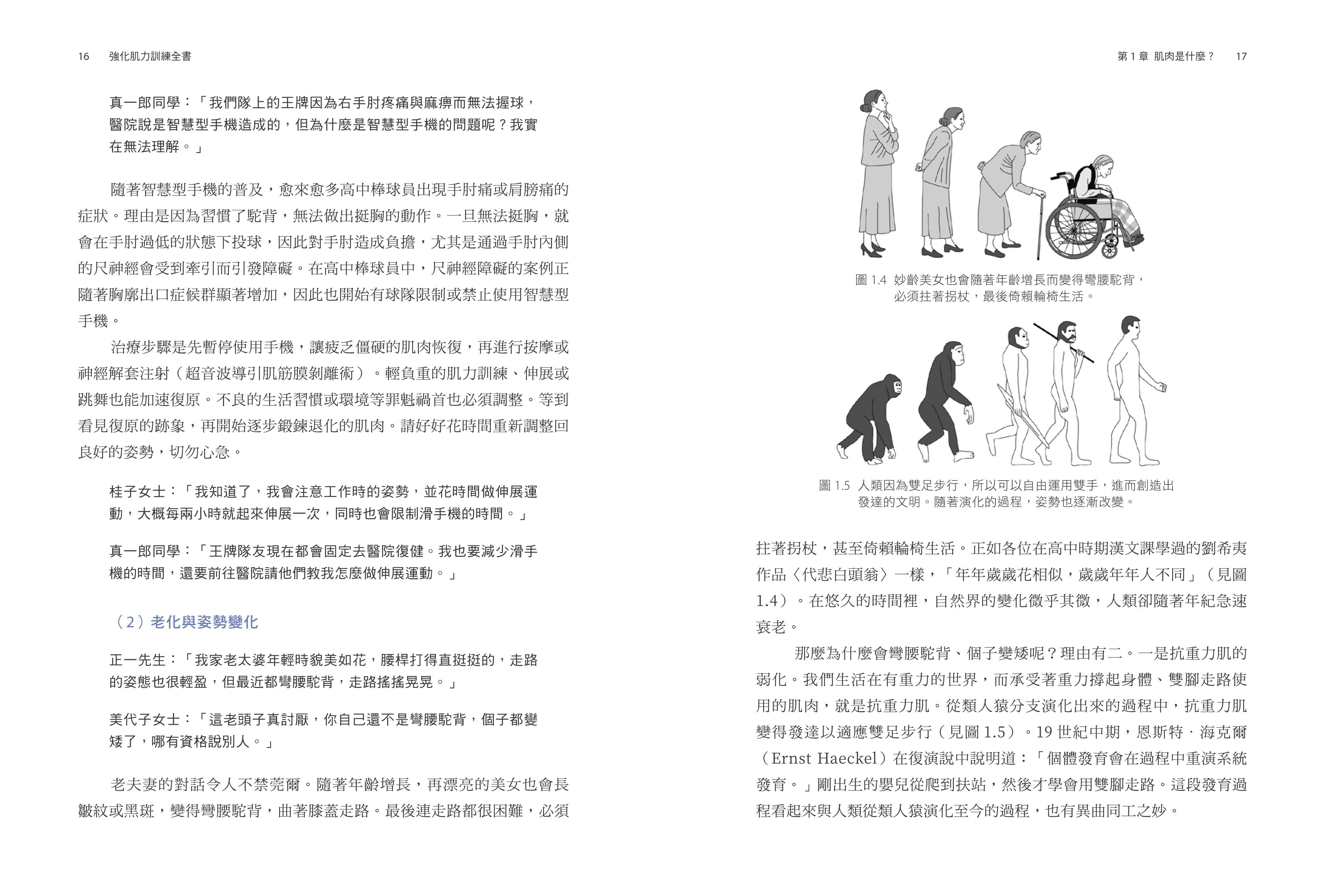
| 中文書名 | 強化肌力訓練全書:東大肌力學教授、骨科醫師及福岡軟銀鷹教練,寫給訓練者的科學化鍛鍊指南 |
| 原文書名 | 筋力強化の教科書 |
| 作 者 | 石井直方、柏口新二、高西文利 |
| 譯 者 | 劉格安 |
| 審 訂 | 王啟安 |
| 系 列 | 健康力 |
| 出 版 | 聯經出版 |
| 出版日期 | 2023/07/06 |
| EAN | 9789570869774 |
| 書本尺寸 | 長23×寬17×高1.4cm / 228頁 |
| 印 刷 | 平裝 / 18開 / 套色印刷 |
內容簡介
東大肌力學教授×骨科醫師×福岡軟銀鷹教練,聯手出擊!
從動作、呼吸、營養到休息,完整說明肌力訓練原理
一本從健身新手、運動員到體能教練等,適合所有人的肌力訓練書
──收錄54種常見的肌力訓練項目──
★日本亞馬遜書店4.5顆星好評推薦★ 本書的三位作者皆是肌力訓練領域的專家,長期在第一線指導運動員及選手,經驗豐富。
他們發現,雖然愈來愈多人開始重視肌力訓練,但過度訓練、追求數字等現象也層出不窮,
比起強化肌力,更多人選擇忽略身體的反應,只想挑戰高重量、高負荷等。
有鑑於此,三位專家決定分別從不同立場,來談論「肌力訓練」的重要性。
這些內容包括──
★為什麼要做「肌力訓練」? 隨著年齡增長或活動量的減少,肌肉會開始萎縮,
久而久之會無法好好支撐身體。
為了減緩退化、預防受傷、減少脂肪等目的,
會建議透過各式訓練項目來強化肌肉。
★「健力三項」是什麼?為何重要? 身體有所謂的三大肌群,即腿、胸、背。
這些肌肉對於我們每天能健康生活,或在運動中表現活躍有很大的貢獻。
為了鍛鍊這些肌肉群,會使用槓鈴進行三種基本肌力訓練,
即深蹲(腿)、臥推(胸)及硬舉(背)。
★如何提高「肌力訓練」的效果? 除了正確呼吸,挑選安全護具、攝取健康飲食及適當的休息,均能提高訓練的效果。
此外,伸展運動能提高柔軟度,強化肌力訓練的效果,
甚至提升競技力、減少受傷。
除了上述內容,本書也收錄超過百張圖片,
以圖解形式說明肌肉原理及訓練方式,讓你的練肌之路更有效率。
本書特色
1.由長期在現場教學的肌力專家所著,並以科學原理進行實證。
2.訓練項目由真人示範,並提供照片,學習更容易。
3.書末收錄54種訓練項目,可依個人能力來練習。
目次
- 【作者序1】把基礎做到極致,才是肌力訓練的原理 石井直方
- 【作者序2】「肌力訓練」在運動器官治療中的角色 柏口新二
- 【作者序3】從「現場指導」的立場來談肌力訓練 高西文利
-
第1章 肌肉是什麼?
- 1.1 日常生活與肌肉
- 1.2 大眾對「肌力訓練」的誤解
- 1.3 肌肉與疼痛
-
-
第2章 認識肌肉&肌力訓練
- 2.1 一起來認識肌肉——肌肉的功能
- 2.2 用「動保熱血」解析肌力訓練
- 2.3 肌肥大的原理
- 2.4 肌力訓練的理論
-
-
第3章 肌力訓練的實踐
- 3.1 訓練的原理與原則
- 3.2 訓練的負重
- 3.3 自重訓練
- 3.4 自由重量與機械
-
-
重要訓練項目的理論&實踐
- 深蹲(關於深蹲/圖解深蹲)
- 臥推 (關於臥推/圖解臥推)
- 硬舉(關於硬舉/圖解硬舉)
- 俯身划船(關於俯身划船/圖解俯身划船)
-
第4章 如何提高肌力訓練的效果?
- 4.1 熱身運動及緩和運動
- 4.2 伸展運動
- 4.3 飲食及營養
- 4.4 休息
- 4.4 休息
-
-
第5章 關於肌力訓練,最多人問的5個問題
- Q1「肌力訓練」能治好腰痛嗎?
- Q2「肌力訓練」能預防肩膀或手肘脫臼嗎?
- Q3 如果有肌力,手術會恢復得比較快嗎?
- Q4「肌力訓練」可以治療或預防肩頸僵硬嗎?
- Q5 為什麼上了年紀後,站姿或走路都會歪呢?
-
- 【附錄】圖解54種肌力訓練
- 參考文獻
- 作者介紹
好評推薦
王啟安|國立臺灣大學外國語文學系兼任講師
──專業審訂
Hunter|動知物理治療所院長、物理治療師
王清景|臉書「My way of life」創辦人
吳肇基|骨科專科醫師、臉書粉絲專頁「大夫訓練」編輯
奇德|ACE美國運動委員會教練培訓官
陳曉謙|「佳齡健康」運動醫學總監
──健康推薦(依姓氏筆劃排列)
好評推薦 現代人的生活模式較為靜態,在缺乏足夠的身體活動下,肌肉與骨質隨著年紀流失的速度也會變得更加快速,因此我也不斷提倡重訓的重要性。這本書以淺顯易懂的方式,針對常見的迷思做解答,並詳細地介紹許多我自己也常做的訓練動作,讓讀者可以更清楚瞭解動作的細節與該注意的地方,對於想學習重訓動作的人來說非常適合閱讀。
──Hunter,動知物理治療所院長、物理治療師
清晰的論述、簡明的圖解,讓你輕鬆掌握訓練動作的原則與要領。
──王啟安,國立臺灣大學外國語文學系兼任講師
簡單的事情反覆做,反覆的事情用心做。真正的肌力訓練並沒有什麼神奇的地方,乍看之下會令人感到簡單和無趣,卻不知其中藏著「安全第一」的前提。所以您只要用心地做,就能產生相當神奇的效果,因此我推薦您詳閱《強化肌力訓練全書》,書中透過有趣的問答方式,讓您更能深入地瞭解科學化訓練的精髓。
──王清景,臉書「My way of life」創辦人
以淺顯易懂的文字,讓讀者可以輕鬆地了解肌力訓練對於預防傷痛和慢性疾病,以及促進健康老化的重要性。
──吳肇基,骨科專科醫師、臉書粉絲專頁「大夫訓練」編輯
將健身運動的內容深入淺出,對於健身知識大眾普及化而言,是一本很棒的工具書。
──奇德,ACE美國運動委員會教練培訓官
不用五花八門的方式,只需遵循千錘百鍊的原則,推薦給尚未開始肌力訓練、想要變得健康的人。
──陳曉謙,「佳齡健康」運動醫學總監
作者簡介
作者:
石井直方(Ishii Naokata) 1955年出生。現為東京大學名譽教授、東京大學社會合作講座特任研究員、理學博士。畢業於東京大學理學院,並修畢博士課程。1999~2020年,任職東京大學研究所綜合文化研究科教授。
多年來專攻運動生理學、訓練科學,同時也是戰績輝煌的競技選手,曾於1981年獲得日本全國健美錦標賽冠軍、世界健美錦標賽季軍,1982年獲得亞洲先生冠軍,2001年獲得全日本社會人士大師賽冠軍等殊榮。
在以「運動及肌肉間關係」為主的健康抗老領域中,以淺顯易懂的解說而深獲好評。後以多年研究為本,提倡少量運動亦可獲得碩大效果的「慢速訓練」,因效果顯著,被許多運動選手採用。著有《訓練之前,先看這本書》、《肌肉學入門》、《慢速訓練完全版》(共筆)、《石井直方的肌肉詳解大事典》等多本書籍(皆為暫譯)。
作者:
柏口新二(Kashiwaguchi Shinji) 1955年出生。現為日本國立德島醫院骨科醫師、醫學博士。畢業於德島大學醫學院醫學系,曾任德島大學醫學院骨科講師、國立療養所德島醫院醫師、東京厚生年金醫院骨科部長、JCHO東京新宿醫療中心(前厚生年金醫院)醫師等職位。
從就讀醫學院時期開始,便學習空手道與肌力訓練,之後轉入健力領域,師從中尾達文教練、宮畑豐會長,目前仍持續訓練中,兼專攻運動外傷及障礙等領域。著有《兒童的身體很危險!運動器官障礙》(共筆)、《棒球肘健檢指南》(共同編著)、《手肘實踐講座:深入了解棒球肘剝脫性骨軟骨炎》(共筆)等多本書籍(皆為暫譯)。
作者:
高西文利(Takanishi Fumitoshi) 1955年出生。現為MARUYA健身房經營者、福岡軟銀鷹隊體適能教練。畢業於法政大學,曾獲得1991~1996年日本全國健美錦標賽中量級冠軍、亞洲健美錦標賽中量級冠軍、1993年世界運動會項目第6名(日本史上首位)。
曾任長崎縣運動協會運動醫科學委員、長崎縣健美聯盟會長、長崎縣健力協會理事、日本健美聯盟1級審查員暨指導員。而後擔任三菱重工長崎硬式棒球社、福岡軟銀鷹隊(2010年開始)等球隊的肌力訓練教練。
著有《有用的肌肉與無用的肌肉:寫給運動員的肌力訓練指南》(共筆)、《兒童期的運動外傷障礙與阻力訓練Q&A》(共筆)、《兒童選手也該知道的禁藥防制Q&A》(共筆)、《兒童選手也該知道的運動營養學Q&A》(共筆)等書(皆為暫譯)。
譯者:
劉格安 政治大學畢業,現為專職譯者,譯作類型包含商管、醫學、旅遊、生活、歷史和小說等。
審訂:
王啟安 國立臺灣師範大學翻譯研究所會議口譯組、國立臺灣大學外國語文學系畢業。現任國立臺灣大學外文系兼任講師、國立臺灣科技大學應外系兼任講師、中原大學應外系兼任講師。
是老師、是教練、也是譯者。
Podcast節目:「啟安老師亂講話」主持人。
作者序
【作者序1】把基礎做到極致,才是肌力訓練的原理/東大肌力學教授 石井直方
我決定以「肌力訓練效果的原理」作為研究主題,是1990年的事。目標有二,一是探究肌肥大的原理,並進一步開發出更有效的訓練方法,二是以科學來闡明肌力訓練對健康有益。 轉眼30年過去,如今下至兒童上至高齡者,許多人都視肌力訓練為理所當然。各式各樣的新肌力訓練法受到提倡,也透過網路…
【作者序2】「肌力訓練」在運動器官治療中的角色/骨科醫師 柏口新二
在我以骨科醫師身分開始工作的1983年,有個在醫局讀書會發表自由主題的機會。我發表了30分鐘的演講,主題是「深蹲時雙腳間距、蹲法、體型所造成的重心移動差異」。儘管身為菜鳥醫師,但我學生時期便在中尾達文老師的指導下,練習了5年左右的健力。現在想想,我竟然敢當著一群前輩與權威的面…
【作者序3】從現場指導的立場,來談肌力訓練/福岡軟銀鷹隊體適能教練 高西文利
我從1988年起,就在長崎市經營專門指導肌力訓練的MARUYA健身房,並身兼福岡軟銀鷹隊的訓練顧問(2010年迄今),擔任隊員的體適能教練(指導肌力訓練)。
處於發育階段的中小學生,是為了「促進成長發育」而訓練,高齡者則是為了「預防老化、返老還童」而訓練。這些訓練法與運動員或一般人所做…
內文連載




2.1一起來認識肌肉——肌肉的功能
(1)認識肌肉的四種功能
我們做肌力(阻力)訓練的目的是什麼?
很多人是為了消除多餘的脂肪,打造出結實的身體而訓練,同時也可以預防或改善代謝症候群。此外,也有很多人是為了「預防老化、返老還童」而訓練。對於運動障礙症候群的預防與改善,肌力訓練也是有效的方法。最近越來越常聽到的肌少症,也能藉由肌力訓練有效預防與改善。
在競技運動中,會為了「預防受傷或異常,以在競技中取勝」而訓練,其他還有「促進兒童的成長發育」、「健康管理」、「病後的體力恢復」等各式各樣的目的。
究竟為什麼「肌力訓練」會是達成這些目的的有效手段呢?為了回答這個問題,我們先把焦點放在肌肉上吧!如此一來就會知道,肌肉具有以下「四種功能」(見圖2.1)。
1.活動身體(產生活動)
2.保護身體(吸收衝擊)
3.製造熱能(產生熱能)
4.幫助血液循環(輔助循環)
能夠同時發揮且強力提升上述四種功能的方式,就是肌力訓練。做肌力訓練有助於提升與這些作用相關的功能,最後即可如前文所述,達成各式各樣的目的。
(2)是什麼決定了「肌肉的四種功能」?
肌力訓練能強力提升與肌肉相關的四種功能,但究竟肌力訓練改變了肌肉的哪個部分?只要做肌力訓練,肌力就會變強,隨之而來的是肌肉變粗、變大。此外,如果調整重量並增加次數,就會增強肌耐力。其中,又是什麼與肌肉的四種功能有關呢?
那就是肌肉「量」。藉由肌力訓練「增加肌肉量」,能夠強化肌肉的四種功能。肌力與肌肉橫斷面積成比例,是生理學上已知的事實。一旦肌肉量增加,肌力也會等比例提升。一般都用「肌肥大或肌力增強」來表現,或說得更具體一些,就是「把肌肉變粗、變大、變強」。
為了能更迅速地活動身體、跌倒時承受衝擊以保護關節或內臟、避免受傷或異常,肌肉都是不可或缺的。要促進疲勞的恢復,也需要肌肉製造熱能,來加速新陳代謝。若要打造出更強健的身體,也必須讓攝取均衡飲食後充滿營養的血液,能夠順暢地循環才行。
如果沒有肌肉,就無法活動身體。很多人應該也隨著老化,逐漸意識到這一點吧?若平常沒有做運動,據說從30幾歲開始,下半身的肌肉量每年會減少1%。不過即使過了這個年齡,只要做適度的肌力訓練,還是可以在3個月內增加5%的肌肉。
此外,肌力訓練的附加效果還包括「保持姿勢」與「保護血管及內臟」。不僅如此,最近的研究還發現,肌肉具有內分泌器官的功能,同時也和失智症的預防有關。
(3)肌力增加,能減緩老化
若深入探究肌肉的四種功能,最終將會得到這樣的答案:「肌肉是唯一能對抗老化的器官」。換句話說,「肌肉」能控制時間的流逝或老化的速度。
我們的身體是由消化系統、循環系統、呼吸系統、生殖系統等各種器官所構成。在這些器官中,能夠透過運動直接產生作用,並按照個人意志與努力來改變的,就是運動器官中的肌肉。不僅如此,我們也知道與「四種功能」有關的機能若提升,也會對肌肉以外的器官帶來正面影響。
醫學博士久野譜也在著書中形容:「肌肉是裝設在人體中的時光機器。」(久野,2015)若能強力提升肌肉的四種功能,應該能減緩身體衰老的速度,甚至使其逆轉。
(4)「動保熱血」是什麼?
有一位活躍於1970、80年代奧運賽場上的世界知名女子體操選手,名叫納迪婭・柯曼妮奇(Nadia Comaneci)。我援用了她的名字,把肌肉的四種功能簡稱為「動保熱血」(譯注:作者以日文各取一個發音組合成諧音umaneci)。
1.活動身體的「動」;
2.保護身體的「保」;
3.製造熱能的「熱」;
4.幫助血液循環的「血」。
把這些拼湊在一起,就得到「肌肉的四種功能」=「動保熱血」。
在做訓練指導時,我都會在說明完一遍理論之後,詢問參加者:「肌肉的四種功能有哪些?」很多人都需要一些時間回想,無法回答出全部四種功能。於是我才想出「動保熱血」一詞。這樣簡化以後,很多人就能夠瞬間想起肌肉的四種功能,比較不容易忘記,並刻在腦海裡。接下來,我將以此繼續說明「為什麼人必須做肌力訓練」?
3.1 訓練的原理與原則
與運動有關的肌肉功能,大致上可分為以下三種:
1.肌力
2.肌耐力
3.柔軟度
而為了有效率地提高這些功能,必須理解訓練的「三大原理」:
(1)超負荷原理:即必須給予比目前生活的水準更強的刺激。以運動選手來說,就是一邊接受遠高於日常生活水準的刺激,一邊做技術練習。因此,必須透過補強訓練給予超過技術練習的刺激,使身體做出抵抗(超負荷)。換句話說,除了專業競技的練習,還要做肌力訓練或長跑等運動,好讓身體受到的負荷超過在競技練習中所承受的負擔。
(2)特異性原理:即訓練的效果只會出現在受到刺激的體力要素上。舉例而言,即使透過肌力訓練提升肌力,但如果沒有練習長跑,肌耐力也不會改變。可能也有人會想說,想要透過長跑一併提升肌力,不過如果要提升肌力,還是做深蹲比較能得到更為確實且強力的效果。
(3)可逆性原理:即一旦停止訓練,體力就會回復到原本的水平。此一原則不僅適用於肌力,對於肌耐力或柔軟度也是一樣的道理。訓練必須要持之以恆,否則會逐漸失去效果。
這些與體力要素相關的三大原理,可以說是所有訓練都共通的原理。除此之外,還有以下五種所謂的「訓練原則」:
(1)意識性原則:即「具備高度的意識投入訓練」。理解以生理學為基礎的訓練三大原理,然後依照目的建立合適的訓練計畫,並持之以恆地努力實踐。
(2)全面性原則:即「全面性且均衡地提升體力要素」。在訓練過程中,必須均衡提升肌力、肌耐力與柔軟度,而不是只偏重其中一種。在肌力訓練中,則必須毫無遺漏地訓練各部位(腿、胸、背、肩、臂、腹)的肌肉。除此之外,還有補充全面性原則的「專門性原則」,也就是配合專門競技的特性,重點式地針對該競技特有的體力要素做訓練。專門性原則必須在以全面性原則為基礎的前提下遵循。
(3)個別性原則:即訓練計畫的內容應「依照訓練者的個別性做決定」。舉例而言,如果是以提高肌力為目的,那麼用80公斤的重量做臥推,對於能做到100公斤/10次的人來說就太輕了,對於能做到50公斤/10次的人來說就太重了。必須按照每個人的肌力進行調整。
(4)漸進性原則:即隨著訓練的進行,「逐步調高強度或量」。如果一直做同樣的重量與次數,久而久之將不再進步。
(5)反覆性原則:即訓練要「規律地反覆進行達一定期間以上」。為了讓訓練能見到成效,必須持續進行。另一方面,也必須避免訓練過度或過量。當持續訓練卻不再見到效果時,適時「休息」也是非常重要的事。
關於深蹲
對肌肥大或增強肌力貢獻最多的就是「深蹲」。由於同時也會使用到背肌或腹肌等軀幹的肌群,因此也能使上半身與下半身平衡。雖然堪稱是「運動(訓練)之王」,但也因為認真做起來會非常辛苦,所以很容易成為被敬而遠之的項目。由於是做起來最痛苦的項目,因此當做到力竭(無法再重複)的程度時,內心會充滿無可取代的喜悅。持之以恆地做正確的深蹲,將會帶來長壽等各種好處。
深蹲時,肌肉與關節的運作
深蹲時會用到髖關節、膝關節與踝關節。髖關節屬於球窩關節,骨頭的末端是由圓球與臼窩組合在一起,可以朝各種方向彎曲或旋轉。因此雙腳的距離可以容許到一定程度的範圍,且能隨個人的體型或柔軟度做調整。膝關節是屈戌關節,構造像打開的門一樣,只能朝著一個方向運動。因此在蹲下時,腳尖與膝蓋方向隨時都要保持一致。
蹲低的時候,上半身雖然要向前傾,但脊椎應保持挺直。脊椎的構造像是堆疊的積木一樣,椎體與椎間盤交錯排列,椎體後側的空洞,則由脊髓(一種柔軟的柱狀組織)貫穿其中。各個接合處都有韌帶緊緊包覆在上面,使椎體不會分散,椎間盤不會飛出來。如果脊椎向前彎曲(駝背),就會對彎曲部分的腰椎椎間盤前側造成過度的負擔,對於維持該結構也會產生問題。
深蹲時,主要使用到下半身肌肉,包括大腿前側的股四頭肌、大腿後側的膕旁肌,以及上方的臀大肌。假如蹲得更深,也會對內收肌群帶來更大的刺激。
膕旁肌是股二頭肌、半腱肌與半膜肌,共三種肌肉的統稱,形狀與梭狀肌(平行肌)相近。與其說它適合發揮強大的力量,不如說因為肌纖維很長,所以更適合做較大的動作。此外,它是跨過髖關節與膝關節的雙關節肌,可以同時做到髖關節的伸展(大腿向後伸展),與膝關節的屈曲(彎曲膝蓋)動作。這是走路或跑步時,腿部後側的動作。
臀大肌是單關節肌,從鞠躬狀態伸展髖關節的動作,會與膕旁肌一起運作,但在髖關節向前彎曲的狀態下(屈曲位),臀大肌的運作會變強。
股四頭肌(股直肌、股中間肌、股內側肌、股外側肌)是羽狀肌,肌纖維的走行方向像鳥類羽毛一樣呈斜向,與梭狀肌(平行肌)比起來肌纖維較短,在相同體積中的肌纖維數較多,因此適合發揮強大力量。其中股直肌是雙關節肌,可以同時進行髖關節屈曲(大腿向前抬起)與膝關節伸展(伸展膝蓋)的動作。這是走路或跑步時的前腳動作,以及踢足球的動作。
當前腳在短跑過程中抓地時,股四頭肌會使出強大的力量支撐身體,後腳則由膕旁肌迅速折起膝關節,以減少腿的轉動慣量,同時臀大肌會變成主角,大力地伸展髖關節。這是充分發揮各種肌肉作用的動作。
在深蹲的動作中,股四頭肌與膕旁肌的關係則變得有點複雜。站起來時,髖關節與膝關節會同時伸展。膕旁肌雖然是髖關節的伸肌,但對於膝關節來說卻是屈肌,因此不在這個時候使用,而把髖關節的伸展全部交給臀大肌,看起來是比較有效率的方法。不過,實際上還是會使用到膕旁肌。此時,股四頭肌為了伸展膝蓋而出力,膕旁肌就會一邊承受股四頭肌伸展膝蓋的作用,一邊發揮伸張性肌力,並與臀大肌協力完成伸展髖關節的作用。股四頭肌、臀大肌與膕旁肌的「共同收縮」,能產生用力站起來的動作或跳躍的動作。另一方面,這也是造成膕旁肌拉傷等障礙的主因。
此外,軀幹的伸展(後彎)也是同時作用。這種時候也會使用到穩定軀幹的腹肌群(主要是腹直肌)、背肌群(主要是豎脊肌),以及下腹深處的髂腰肌(腰大肌+髂肌)。腰大肌跨過髖關節連接上半身與下半身,在深蹲時會發揮重要功能,讓腰椎保持在正常狀態。
有研究報告指出,黑人的腰大肌比其他人種粗三倍。這一點似乎影響到運動適性,使他們更適合田徑運動中的短跑競技。腰大肌可以藉由深蹲(平行蹲或全深蹲)來增加粗度。
...











